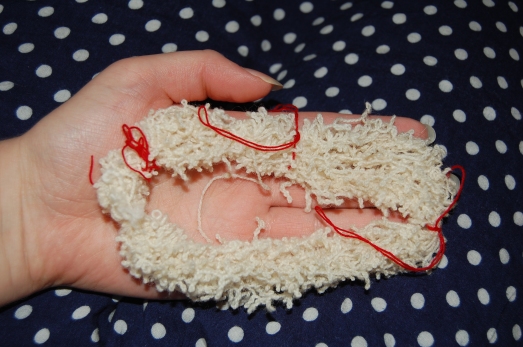More recent spinning.
I spun two lots of singles then wound them both together into a plying ball. Guess what? When I reached the end of one of my spindles I only had a foot and a half left on the other spindle!!! I just guessed the spindles had about the same amount on by holding them in my hands and I was THAT CLOSE!!! Ok, a coincidence, as I’m not that good, but impressive! Right? Not something that happens every day, anyway.
I then plyed on my medieval spindle but using it as a drop spindle. The fast spin spins longer when you stand up and quickly drop your heights worth of thread for it to spin from. Sometimes I didn’t get a good spin but most times due to the tapered ends of my spindle stick I did.
Here is my spindle full.

I was worried that I was putting too much spin into my ply so for each length I plyed (a length being my eyes to the floor when standing) I twisted the spindle once and when it started to slow I walked the spindle up the thread and wound on.
Here is my spinning on the niddy noddy.



Here is the yarn straight off the niddy noddy before washing.

I thought this would have a lot more active twist than it does! This yarn at the moment has a nice feel to it. Soft and tactile. Not too hard but not without any movement either. Springy without being twisty. Of course, I don’t actually know what I’m aiming for, but I like the feel of it. When I start using my yarn up I’ll be able to look at the finished results and refer back to my notes of how it felt so I’ll know what to aim for in the future. It’s quite possible I’ll need more twist than this if I’m looking to use it for warp thread. I’ve washed it and it’s hanging to dry (unweighted) right now so I’ll see how it looks in the morning.
Talking about too much twist, remember how I said my first wool yarn had way too much twist in it and I washed it again and dried it on the niddy noddy? Well, out of curiosity I washed it again and didn’t put it on the niddy noddy to dry. This is what it did.

Yes, that’s a whole skein! It relaxed a bit after I stretched it out a bit (it was really fun to play with!) but now I wonder if it can be used. Ive heard there’s no thread to tight or too twisted to be used for weaving, but, really?

I mean, if I wove with this what would happen the moment the fabric got wet? Would it all shrivel up?
Well, I guess I could find out! New experementation is looming… 😉








